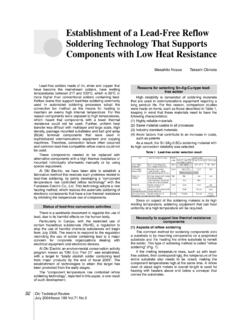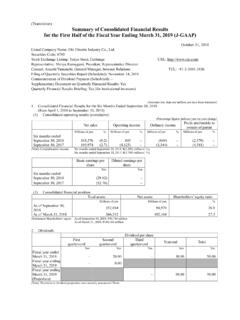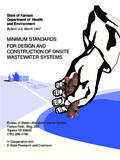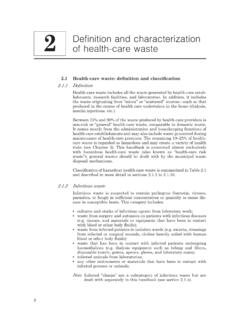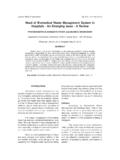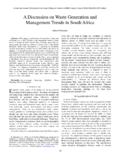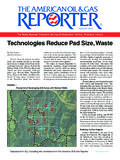Transcription of Reduction of Fluorine-containing Industrial Waste Using ...
1 53 January 1998 Oki Technical ReviewVol. 63 Figure 1: Treatment flow of Fluorine-containing Waste water (conventional method)First processSecond processCalcium hydroxide solutionFluorine- containing Waste waterRaw water storage tankFirst reaction tankDischarged water (Note 1)*First coagulating sedimentation tank*Note 1 When a secondary treatment is necessary, this water is transferred to the second reaction treatment agentSecond reaction tankSecond coagulating sedimentation tankDehydratorThird processCaF2 CaF2+ AIF3 Special Issue on Global Environment: UDC [ : ] : of Fluorine-containing IndustrialWaste Using Aluminum-solubility MethodHisao KUROSAKI*AbstractAbout 30% of Industrial Waste from semiconductor plants is Fluorine-containing Waste .
2 To decrease this we examineda new Waste treatment method. This paper describes the theory, features and performance of this this method, fluorine contained in Waste is fixated to AIF3 Using an aluminum treatment agent, which reduces fluorinein Waste to a low concentration. Then AIF3 is dissolved, and at the same time, a calcium treatment agent is added tosubstitute AIF3 with CaF2. By this method, the fluorine treatment performance was improved, decreasing Fluorine-containing Waste 75% or more than the conventional calcium precipitation method. Most of the aluminum treatmentagent used for this new method can be reused, therefore the energy saving and cost Reduction effect is high.
3 *Plant Engineering Section, Environmental System Division, Oki Engineering Co. environmental protection is being given a greatdeal of attention, and standards to control the concentra-tion of substances discharged from factories is becomingmore strict every concentration of fluorine in Waste water , for example,is defined as 15mg/l or less by the water Pollution ControlLaw. This value is even 8mg/l or less depending on the localself governing body. Each factory performs the treatment ofwaste water and exhaust gas by various methods to meet thesecontrol values. These treatments generate an enormous amountof sludge, which are reclaimed as Industrial Waste .
4 But thecapacity of reclamation plants is already saturated, and de-creasing Industrial Waste is an urgent plants are no exception, where largeamounts of Waste sludge is discharged. About 30% of wastesludge is generated when treating Fluorine-containing wastewater. To decrease the generation of this Waste , varioustreatments have been examined. In newly established wastewater treatment plants, a new system which uses calciumcarbonate, is having good examined the treatment method Using an alumi-num-solubility method to decrease the fluorine -contain-ing Waste water treatment sludge generated from semicon-ductor plants.
5 This paper first describes the current situa-tion of Fluorine-containing Waste water treatment, thenthe principles, experimental methods and performance oftreatment methods Using an aluminum-solubility methodare situation of fluorine -containingwaste water Coagulating sedimentation method usingcalcium hydroxide (conventional method)The primary Fluorine-containing Waste water treatmentmethod conventionally used was the coagulating sedimentmethod*1 which uses calcium hydroxide {Ca (OH)2} as thetreatment agent. Figure 1 shows the treatment flow.*1 Coagulating sedimentation method is a method to sedimentate solid matter in thesolution utilizing specific gravity of Fluorine-containing Industrial Waste Using Aluminum-solubility Method1.
6 First process (first reaction tank)Calcium hydroxide is added to Fluorine-containing wastewater, and the pH is controlled. fluorine ions thatdissolve in the Waste water combine with calcium ionsand is deposited as calcium Second process (first coagulating sedimentation tank)Since calcium fluoride is alkaline and exhibits lowsolubility, solid and liquid can be easily separated byusing the coagulating sedimentation method. The sepa-ration speed can be accelerated by adding macromo-lecular flocculant. Supernatant liquid after solid-liquidseparation is discharged as treated water and thesedimentated portion is recovered as Third process (dehydrator)Recovered sludge is decreased in volume by a dehydra-tor and is disposed of as Industrial Problems of conventional methodsCalcium hydroxide, which is frequently sold as slakedlime, is generally inexpensive.
7 But the solubility of calciumhydroxide is low, so the quantity of calcium hydroxide thatdissolves in water as calcium ions is very little. Therefore,a large amount of the treatment agent must be added totreat the concentration of the treatment target calcium hydroxide added in the Waste water isrecovered with calcium fluoride as Waste sludge, which is acause to increase Waste sludge more than necessary. Alsobecause of low solubility, calcium hydroxide can decreasethe concentration of fluorine in treated water only to15mg/l. To further decrease this concentration to 8mg/l orless, a secondary treatment (second reaction tank - secondcoagulating sedimentation tank) Using an aluminum treat-ment agent is of Fluorine-containing ConceptUnder certain conditions, aluminum exhibits a higherbonding strength with fluorine compared with can therefore remove fluorine in Waste waterdown to a lower concentration.
8 The problems of alumi-num are that aluminum is much more expensive than thecalcium treatment agent, and sludge generated after treat-ment has a poor dehydrating capability. For these reasons,aluminum is inappropriate for high concentration fluorinetreatment, and therefore is mainly used for low concentra-tion fluorine Waste on the high fluorine removal capability ofaluminum, and the good dehydrating capability and lowcost of calcium, we examined a treatment method thatdecreases Waste Waste water treatment Using aluminum-solubility methodWe experimented with a Waste water treatment based on analuminum-solubility method, and checked the effect.
9 Withthis method, a calcium treatment agent is added to the sludgegenerated after treating Fluorine-containing Waste water withan aluminum treatment agent, and the aluminum of alumi-num fluoride is substituted with calcium. Aluminum insludge dissolves, and is recovered and reused as an aluminumtreatment agent. Figure 2 shows the Waste water treatmentflow of this aluminum-solubility method. This Waste watertreatment system is separated into five processes. Each processis described First processThe recycled aluminum treatment agent, recovered in thefourth process, is added to the Fluorine-containing wasteFigure 2: Treatment flow of Waste water Using aluminum-solubility methodFirst processSecond processNew aluminum treatment agentFluorine- containing Waste waterFirst reactionDischarged waterCalcium treatment agentSubstitutionSecond solid-liquid separationDehydratorFifth processCaF2 AIF3 Recycled aluminum treatment agent recovered by second solid-liquid separationFirst solid-liquid separationTo first reactionThird processFourth processCaF22 HF + Ca(OH)2 CaF2 + 2 H2O 55 January 1998 Oki Technical ReviewVol.
10 63water. When this is insufficient for the fluorine treatment,a new aluminum treatment agent is added. By pH control, fluorine contained in Waste water is deposited as alumi-num fluoride, then fluorine in Waste water is removed byremoving aluminum fluoride. The following chemicalformula shows the reaction of hydrofluoric acid and am-monium fluoride with the aluminum treatment 3 shows the relationship between the volume ofdeposit of aluminum fluoride*2 and the concentration offluorine in treated water *3 obtained from our experi-ment. From Figure 3 we determined the quantity ofaluminum required to add for fluorine Second treatmentRecovered sludge is separated from treated water by solid-liquid separation.




